Keyword Analysis and Systematic Review of China’s Sponge City Policy and Flood Management Research
Abstract
1. Introduction
2. Materials and Methods
2.1. Materials
2.2. Methods
2.3. Research Framework
3. Results
4. Discussion
4.1. Research on Urban Flood Risk and Resilience
4.2. Research on National Strategy and Urban Governance Transformation
4.3. LID Measures and Runoff Control Technologies
4.4. Cost Assessment and Green Infrastructure Integration
5. Conclusions
Author Contributions
Funding
Institutional Review Board Statement
Informed Consent Statement
Data Availability Statement
Conflicts of Interest
References
- Xu, D.H.; Ouyang, Z.Y.; Wu, T.; Han, B.L. Dynamic Trends of Urban Flooding Mitigation Services in Shenzhen, China. Sustainability 2020, 12, 4799. [Google Scholar] [CrossRef]
- Wen, F.; Rong, Q.Q.; Gu, Z.H.; Xie, Y.L.; Su, M.R. Urban flooding risk assessment and mitigation strategies based on optimal allocation of low impact development facilities. Sustain. Cities Soc. 2025, 130, 106652. [Google Scholar] [CrossRef]
- Li, Z.Z.; Dong, M.J.; Wong, T.; Wang, J.B.; Kumar, A.J.; Singh, R.P. Objectives and Indexes for Implementation of Sponge CitiesA Case Study of Changzhou City, China. Water 2018, 10, 623. [Google Scholar] [CrossRef]
- Peng, X.; Wen, S.P. The Economic Performance of Urban Sponge Parks Uncovered by an Integrated Evaluation Approach. Land 2025, 14, 1099. [Google Scholar] [CrossRef]
- Zhang, S.Y.; Zevenbergen, C.; Rabé, P.; Jiang, Y. The Influences of Sponge City on Property Values in Wuhan, China. Water 2018, 10, 766. [Google Scholar] [CrossRef]
- Li, Y.; Ye, S.S.; Wu, Q.Z.; Wu, Y.J.; Qian, S.H. Analysis and countermeasures of the “7.20” flood in Zhengzhou. J. Asian Archit. Build. Eng. 2023, 22, 3782–3798. [Google Scholar] [CrossRef]
- Zhou, Y.X.; Sharma, A.; Masud, M.; Gaba, G.S.; Dhiman, G.; Ghafoor, K.Z.; AlZain, M.A. Urban Rain Flood Ecosystem Design Planning and Feasibility Study for the Enrichment of Smart Cities. Sustainability 2021, 13, 5205. [Google Scholar] [CrossRef]
- Li, J.K.; Yao, Y.T.; Ma, M.H.; Li, Y.J.; Xia, J.; Gao, X.J. A Multi-Index Evaluation System for Identifying the Optimal Configuration of LID Facilities in the Newly Built and Built-up Urban Areas. Water Resour. Manag. 2021, 35, 2129–2147. [Google Scholar] [CrossRef]
- Zeng, L.Y.; Li, R.Y.M.; Zeng, H.L.; Song, L.X. Perception of sponge city for achieving circularity goal and hedge against climate change: A study on Weibo. Int. J. Clim. Change Strateg. Manag. 2024, 16, 362–384. [Google Scholar] [CrossRef]
- Xiang, C.Y.; Liu, J.H.; Shao, W.W.; Mei, C.; Zhou, J.J. Sponge city construction in China: Policy and implementation experiences. Water Policy 2019, 21, 19–37. [Google Scholar] [CrossRef]
- Shao, W.W.; Su, X.; Lu, J.; Liu, J.H.; Yang, Z.Y.; Mei, C.; Liu, C.; Lu, J.H. Urban Resilience of Shenzhen City under Climate Change. Atmosphere 2021, 12, 537. [Google Scholar] [CrossRef]
- Wang, Y.T.; Meng, F.L.; Liu, H.X.; Zhang, C.; Fu, G.T. Assessing catchment scale flood resilience of urban areas using a grid cell based metric. Water Res. 2019, 163, 114852. [Google Scholar] [CrossRef] [PubMed]
- Lv, H.; Guan, X.J.; Meng, Y. Comprehensive evaluation of urban flood-bearing risks based on combined compound fuzzy matter-element and entropy weight model. Nat. Hazards 2020, 103, 1823–1841. [Google Scholar] [CrossRef]
- Zhang, X.; Zhou, C.; Luo, H.; Zeng, X.; Shu, Z.; Jiang, L.; Wang, Z.; Fei, Z. Study on the risk of rainstorm waterlogging disaster in hilly cities based on Sponge City construction-liking Suining. Urban Clim. 2024, 53, 101829. [Google Scholar] [CrossRef]
- Xie, Z.Y.; Peng, B.H. A Framework for Resilient City Governance in Response to Sudden Weather Disasters: A Perspective Based on Accident Causation Theories. Sustainability 2023, 15, 2387. [Google Scholar] [CrossRef]
- Fu, G.T.; Zhang, C.; Hall, J.W.; Butler, D. Are sponge cities the solution to China’s growing urban flooding problems? Wiley Interdiscip. Rev.-Water 2023, 10, e1613. [Google Scholar] [CrossRef]
- Xu, J.B.; Zhu, M.L.; Zhan, S.G. A neglected climate risk: The price effect of urban waterlogging. J. Environ. Manag. 2024, 352, 119851. [Google Scholar] [CrossRef]
- Liang, C.M.; Zhang, X.; Xu, J.; Pan, G.Y.; Wang, Y. An integrated framework to select resilient and sustainable sponge city design schemes for robust decision making. Ecol. Indic. 2020, 119, 106810. [Google Scholar] [CrossRef]
- Cheng, T.; Xu, Z.X.; Hong, S.Y.; Song, S.L. Flood Risk Zoning by Using 2D Hydrodynamic Modeling: A Case Study in Jinan City. Math. Probl. Eng. 2017, 2017, 5659197. [Google Scholar] [CrossRef]
- Cheng, T.; Huang, B.S.; Yang, Z.F.; Qiu, J.; Zhao, B.K.; Xu, Z.X. On the effects of flood reduction for green and grey sponge city measures and their synergistic relationship-Case study in Jinan sponge city pilot area. Urban Clim. 2022, 42, 101058. [Google Scholar] [CrossRef]
- Mei, C.; Liu, J.H.; Wang, H.; Yang, Z.Y.; Ding, X.Y.; Shao, W.W. Integrated assessments of green infrastructure for flood mitigation to support robust decision-making for sponge city construction in an urbanized watershed. Sci. Total Environ. 2018, 639, 1394–1407. [Google Scholar] [CrossRef] [PubMed]
- Wang, Y.T.; Liu, Z.; Wang, G.Q.; Xue, W.C. Cellular automata based framework for evaluating mitigation strategies of sponge city. Sci. Total Environ. 2021, 796, 148991. [Google Scholar] [CrossRef] [PubMed]
- Avashia, V.; Garg, A. Implications of land use transitions and climate change on local flooding in urban areas: An assessment of 42 Indian cities. Land Use Policy 2020, 95, 104571. [Google Scholar] [CrossRef]
- Jia, S.F.; Li, Y.Y.; Lü, A.F.; Liu, W.H.; Zhu, W.B.; Yan, J.B.; Liang, Y.; Xiang, X.Z.; Guan, Z.L. City storm-flood events in China, 1984–2015. Int. J. Water Resour. Dev. 2019, 35, 605–618. [Google Scholar] [CrossRef]
- Wang, Y.B.; Xie, X.H.; Liang, S.L.; Zhu, B.W.; Yao, Y.; Meng, S.S.; Lu, C.Y. Quantifying the response of potential flooding risk to urban growth in Beijing. Sci. Total Environ. 2020, 705, 135868, Correction in Sci. Total Environ. 2020, 719, 136520. [Google Scholar] [CrossRef]
- Hou, J.J.; Zhang, Y.Y.; Xia, J.; Wang, Y.L.; Zhang, S.Y.; Pan, X.Y.; Yang, M.Y.; Leng, G.Y.; Dou, M. Simulation and Assessment of Projected Climate Change Impacts on Urban Flood Events: Insights From Flooding Characteristic Metrics. J. Geophys. Res.-Atmos. 2022, 127, e2021JD035360. [Google Scholar] [CrossRef]
- Wang, Y.; Liu, X.; Huang, M.S.; Zuo, J.; Rameezdeen, R. Received vs. given: Willingness to pay for sponge city program from a perceived value perspective. J. Clean. Prod. 2020, 256, 120479. [Google Scholar] [CrossRef]
- Zhao, Y.J.; Xia, J.; Xu, Z.X.; Qiao, Y.F.; Shen, J.M.; Ye, C.L. Impact of Urbanization on Regional Rainfall-Runoff Processes: Case Study in Jinan City, China. Remote Sens. 2023, 15, 2383. [Google Scholar] [CrossRef]
- Zhou, X.Y.; Bai, Z.J.; Yang, Y.H. Linking trends in urban extreme rainfall to urban flooding in China. Int. J. Climatol. 2017, 37, 4586–4593. [Google Scholar] [CrossRef]
- Randall, M.; Sun, F.B.; Zhang, Y.Y.; Jensen, M.B. Evaluating Sponge City volume capture ratio at the catchment scale using SWMM. J. Environ. Manag. 2019, 246, 745–757. [Google Scholar] [CrossRef]
- Bah, A.; Zhang, H.B.; Bah, A.; He, J.F.; Luo, Z.M. Study of the applicability of Sponge City concepts for flood mitigation based on LID (low impact development) measures: A case study in Conakry City, Republic of Guinea. Water Sci. Technol. 2023, 88, 901–921. [Google Scholar] [CrossRef]
- Li, C.C.; Zhang, Y.D.; Wang, C.; Shen, R.Z.; Gisen, J.I.A.; Mu, J. Stormwater and flood simulation of sponge city and LID mitigation benefit assessment. Environ. Sci. Pollut. Res. 2023, 32, 13089–13105. [Google Scholar] [CrossRef]
- Guo, Z.; Zhang, X.; Winston, R.; Smith, J.; Yang, Y.F.; Tao, S.Y.; Liu, H.Y. A holistic analysis of Chinese sponge city cases by region: Using PLS-SEM models to understand key factors impacting LID performance. J. Hydrol. 2024, 637, 131405. [Google Scholar] [CrossRef]
- Jiang, Y.; Qiu, L.; Gao, T.; Zhang, S.X. Systematic Application of Sponge City Facilities at Community Scale Based on SWMM. Water 2022, 14, 591. [Google Scholar] [CrossRef]
- Fei, Y.M.; Rene, E.R.; Shang, Q.Y.; Singh, R.P. Comprehensive effect evaluation of LID facilities implemented in sponge campuses: A case study. Ecol. Indic. 2023, 155, 110912. [Google Scholar] [CrossRef]
- Luan, Q.H.; Fu, X.R.; Song, C.P.; Wang, H.C.; Liu, J.H.; Wang, Y. Runoff Effect Evaluation of LID through SWMM in Typical Mountainous, Low-Lying Urban Areas: A Case Study in China. Water 2017, 9, 439. [Google Scholar] [CrossRef]
- Zheng, P.; Ke, J.Y.; Pan, W.B.; Zhan, X.; Cai, Y.B. Effects of Low-Impact Development on Urban Rainfall Runoff under Different Rainfall Characteristics. Pol. J. Environ. Stud. 2019, 28, 771–783. [Google Scholar] [CrossRef]
- Jiang, A.L.Z.; McBean, E.A. Performance of lot-level low impact development technologies under historical and climate change scenarios. J. Hydro-Environ. Res. 2021, 38, 4–13. [Google Scholar] [CrossRef]
- Sun, H.Y.; Dong, Y.X.; Lai, Y.; Li, X.Y.; Ge, X.Y.; Lin, C.S. The Multi-Objective Optimization of Low-Impact Development Facilities in Shallow Mountainous Areas Using Genetic Algorithms. Water 2022, 14, 2986. [Google Scholar] [CrossRef]
- Hu, M.C.; Zhang, X.Q.; Li, Y.; Yang, H.; Tanaka, K. Flood mitigation performance of low impact development technologies under different storms for retrofitting an urbanized area. J. Clean. Prod. 2019, 222, 373–380. [Google Scholar] [CrossRef]
- Zhang, Y.X.; Zhao, W.H.; Chen, X.; Jun, C.; Hao, J.L.; Tang, X.N.; Zhai, J. Assessment on the Effectiveness of Urban Stormwater Management. Water 2021, 13, 4. [Google Scholar] [CrossRef]
- Wu, J.S.; Chen, Y.; Yang, R.; Zhao, Y.H. Exploring the Optimal Cost-Benefit Solution for a Low Impact Development Layout by Zoning, as Well as Considering the Inundation Duration and Inundation Depth. Sustainability 2020, 12, 4990. [Google Scholar] [CrossRef]
- Yang, W.Y.; Zhang, J.; Krebs, P. Low impact development practices mitigate urban flooding and non-point pollution under climate change. J. Clean. Prod. 2022, 347, 131320. [Google Scholar] [CrossRef]
- Gao, Z.; Zhang, Q.H.; Xie, Y.D.; Wang, Q.; Dzakpasu, M.; Xiong, J.Q.; Wang, X.C. A novel multi-objective optimization framework for urban green-gray infrastructure implementation under impacts of climate change. Sci. Total Environ. 2022, 825, 153954. [Google Scholar] [CrossRef] [PubMed]
- Li, B.; Dong, S.L.; Huang, Y.F.; Wang, G.Q. Development of a Heterogeneity Analysis Framework for Collaborative Sponge City Management. Water 2019, 11, 1995. [Google Scholar] [CrossRef]
- Yao, Y.C.; Hu, C.H.; Liu, C.S.; Yang, F.; Ma, B.Y.; Wu, Q.; Li, X.A.; Soomro, S.E.H. Comprehensive performance evaluation of stormwater management measures for sponge city construction: A case study in Gui’an New District, China. J. Flood Risk Manag. 2022, 15, e12834. [Google Scholar] [CrossRef]
- Xu, C.Q.; Shi, X.M.; Jia, M.Y.; Han, Y.; Zhang, R.R.; Ahmad, S.; Jia, H.F. China Sponge City database development and urban runoff source control facility configuration comparison between China and the US. J. Environ. Manag. 2022, 304, 114241. [Google Scholar] [CrossRef]
- He, L.; Li, S.; Cui, C.H.; Yang, S.S.; Ding, J.; Wang, G.Y.; Bai, S.W.; Zhao, L.; Cao, G.L.; Ren, N.Q. Runoff control simulation and comprehensive benefit evaluation of low-impact development strategies in a typical cold climate area. Environ. Res. 2022, 206, 112630. [Google Scholar] [CrossRef]
- Zhang, D.Q.; Mei, C.; Ding, X.Y.; Liu, J.H.; Fu, X.R.; Wang, J.; Wang, D. Impacts of Rainstorm Characteristics on Runoff Quantity and Quality Control Performance Considering Integrated Green Infrastructures. Sustainability 2022, 14, 11284. [Google Scholar] [CrossRef]
- Zhu, Y.F.; Xu, C.Q.; Liu, Z.J.; Yin, D.K.; Jia, H.F.; Guan, Y.T. Spatial layout optimization of green infrastructure based on life-cycle multi-objective optimization algorithm and SWMM model. Resour. Conserv. Recycl. 2023, 191, 106906. [Google Scholar] [CrossRef]
- Wang, Z.L.; Li, S.S.; Wu, X.Q.; Lin, G.S.; Lai, C.G. Impact of spatial discretization resolution on the hydrological performance of layout optimization of LID practices. J. Hydrol. 2022, 612, 128113. [Google Scholar] [CrossRef]
- Li, Q.; Wang, F.; Yu, Y.; Huang, Z.C.; Li, M.T.; Guan, Y.T. Comprehensive performance evaluation of LID practices for the sponge city construction: A case study in Guangxi, China. J. Environ. Manag. 2019, 231, 10–20. [Google Scholar] [CrossRef]
- Xu, T.; Engel, B.A.; Shi, X.M.; Leng, L.Y.; Jia, H.F.; Yu, S.L.; Liu, Y.Z. Marginal-cost-based greedy strategy (MCGS): Fast and reliable optimization of low impact development (LID) layout. Sci. Total Environ. 2018, 640, 570–580. [Google Scholar] [CrossRef]
- Xie, X.H.; Qin, S.Y.; Gou, Z.H.; Yi, M. Engaging professionals in urban stormwater management: The case of China’s Sponge City. J. Plan. Lit. 2022, 37, 167. [Google Scholar] [CrossRef]
- Zhu, Y.F.; Shen, X.W.; Rui, S.X.Y.; Sun, X.X.; Wang, J.; Zhang, L.X.; Guan, Y.T. Utilizing multi-objective optimization in improved green infrastructure for enhanced pollution reduction and carbon mitigation in sponge cities. Resour. Conserv. Recycl. 2025, 217, 108179. [Google Scholar] [CrossRef]
- Wang, Y.T.; Sun, M.X.; Song, B.M. Public perceptions of and willingness to pay for sponge city initiatives in China. Resour. Conserv. Recycl. 2017, 122, 11–20. [Google Scholar] [CrossRef]
- Wu, X.Y.; Tang, R.; Wang, Y.T. Evaluating the cost-benefit of LID strategies for urban surface water flooding based on risk management. Nat. Hazards 2024, 120, 10345–10364. [Google Scholar] [CrossRef]
- Zhou, Q.Q.; Luo, J.H.; Qin, Z.; Su, J.H.; Ren, Y. Conceptual planning approach of low impact developments for combined water quality-quantity control at an urban scale: A case study in Southern China. J. Flood Risk Manag. 2022, 15, e12760. [Google Scholar] [CrossRef]
- Kong, F.; Sun, S.; Wang, Y.F. Comprehensive Understanding the Disaster-Causing Mechanism, Governance Dilemma and Targeted Countermeasures of Urban Pluvial Flooding in China. Water 2021, 13, 1762. [Google Scholar] [CrossRef]
- Xu, T.; Li, K.; Engel, B.A.; Jia, H.F.; Leng, L.Y.; Sun, Z.X.; Yu, S.L. Optimal adaptation pathway for sustainable low impact development planning under deep uncertainty of climate change: A greedy strategy. J. Environ. Manag. 2019, 248, 109280. [Google Scholar] [CrossRef] [PubMed]
- Taghizadeh, S.; Khani, S.; Rajaee, T. Hybrid SWMM and particle swarm optimization model for urban runoff water quality control by using green infrastructures (LID-BMPs). Urban For. Urban Green. 2021, 60, 127032. [Google Scholar] [CrossRef]
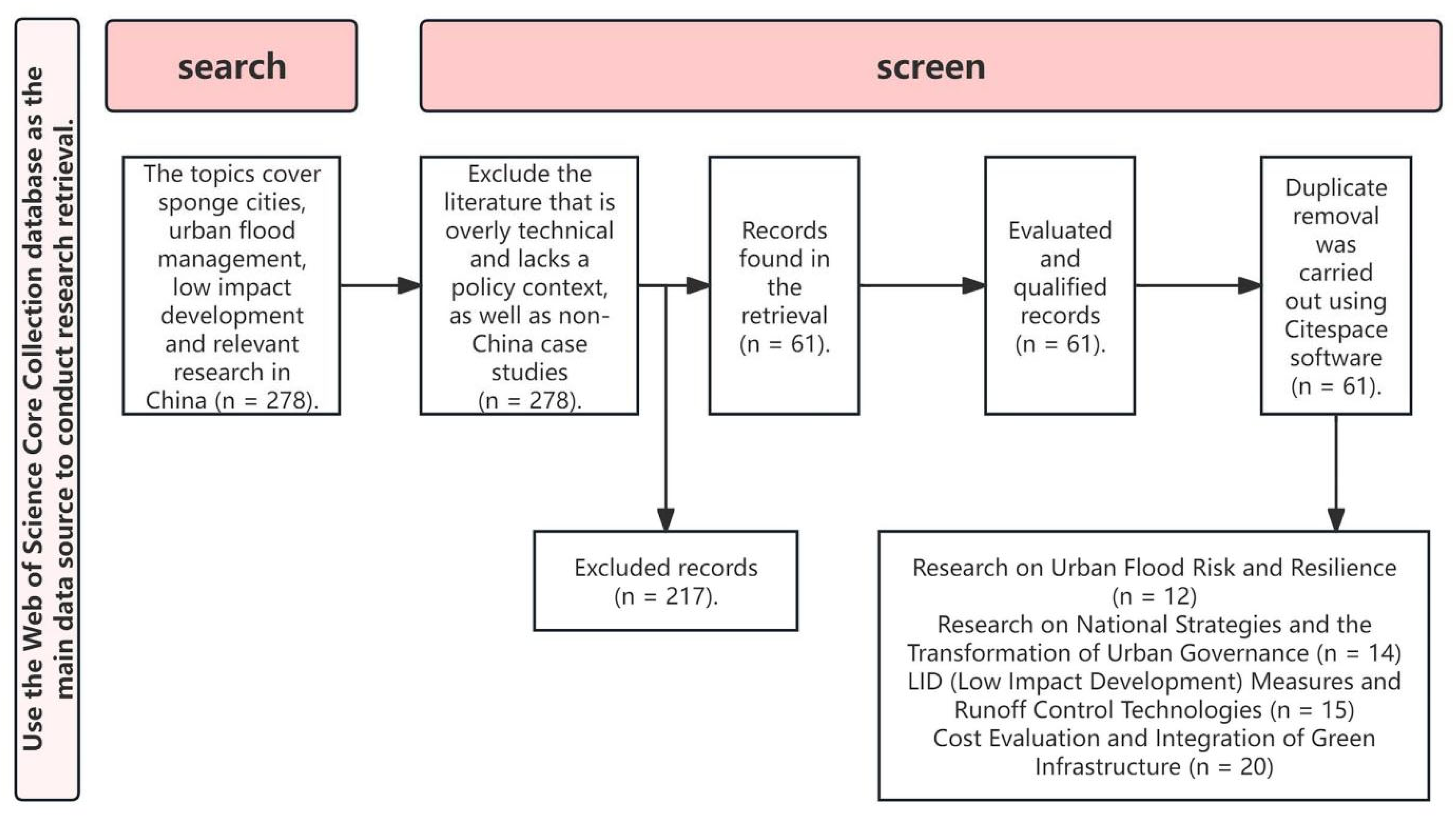

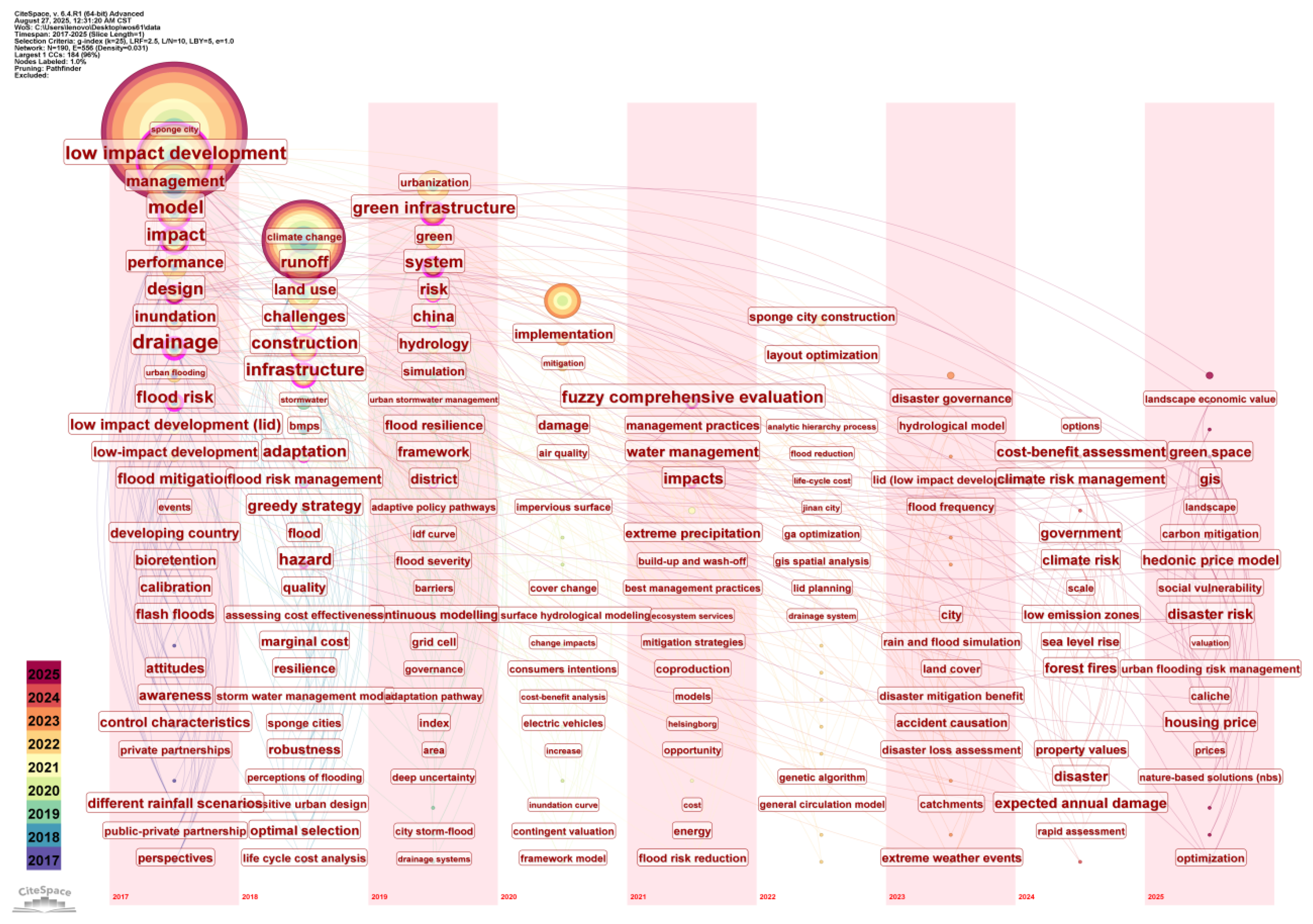

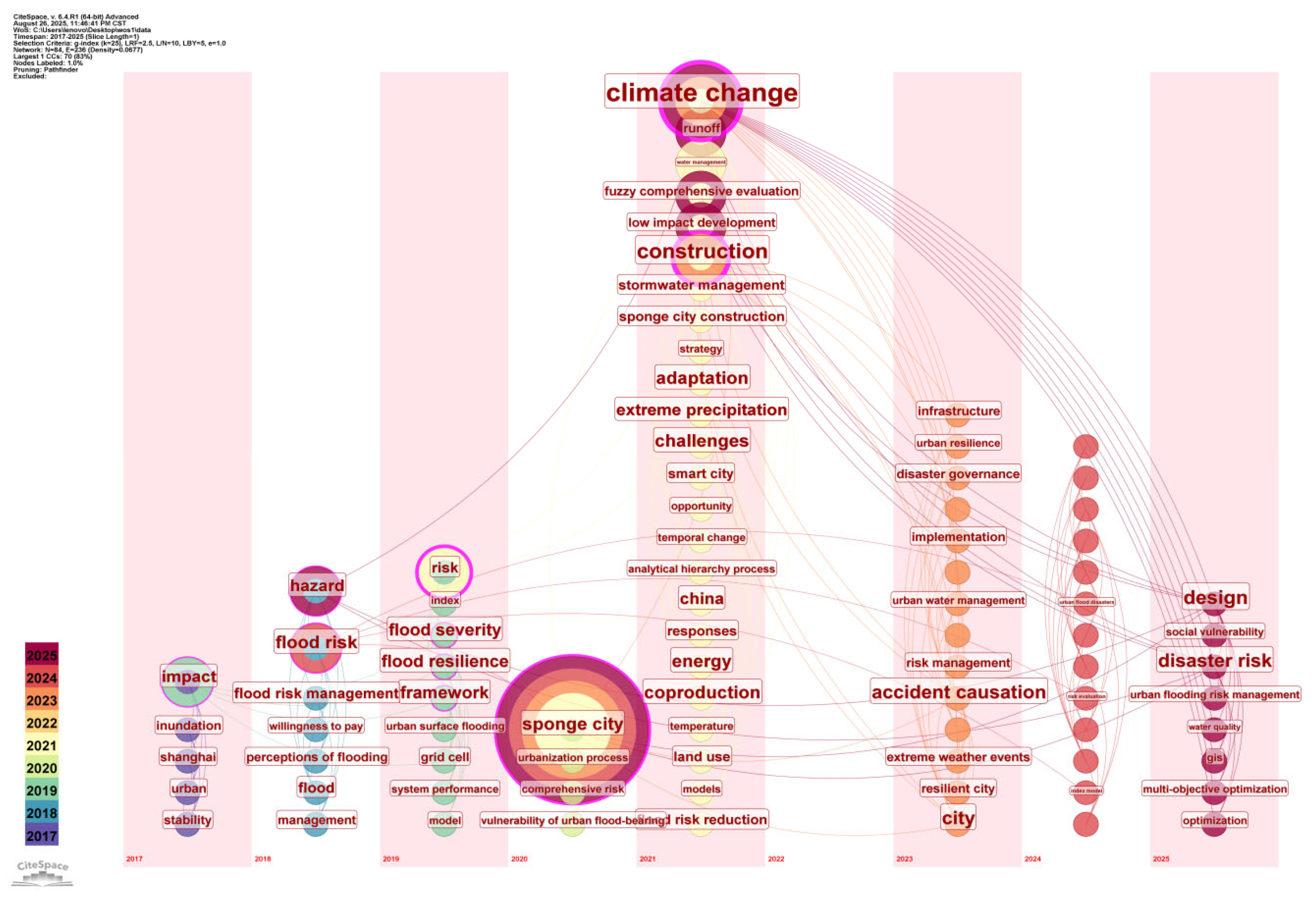

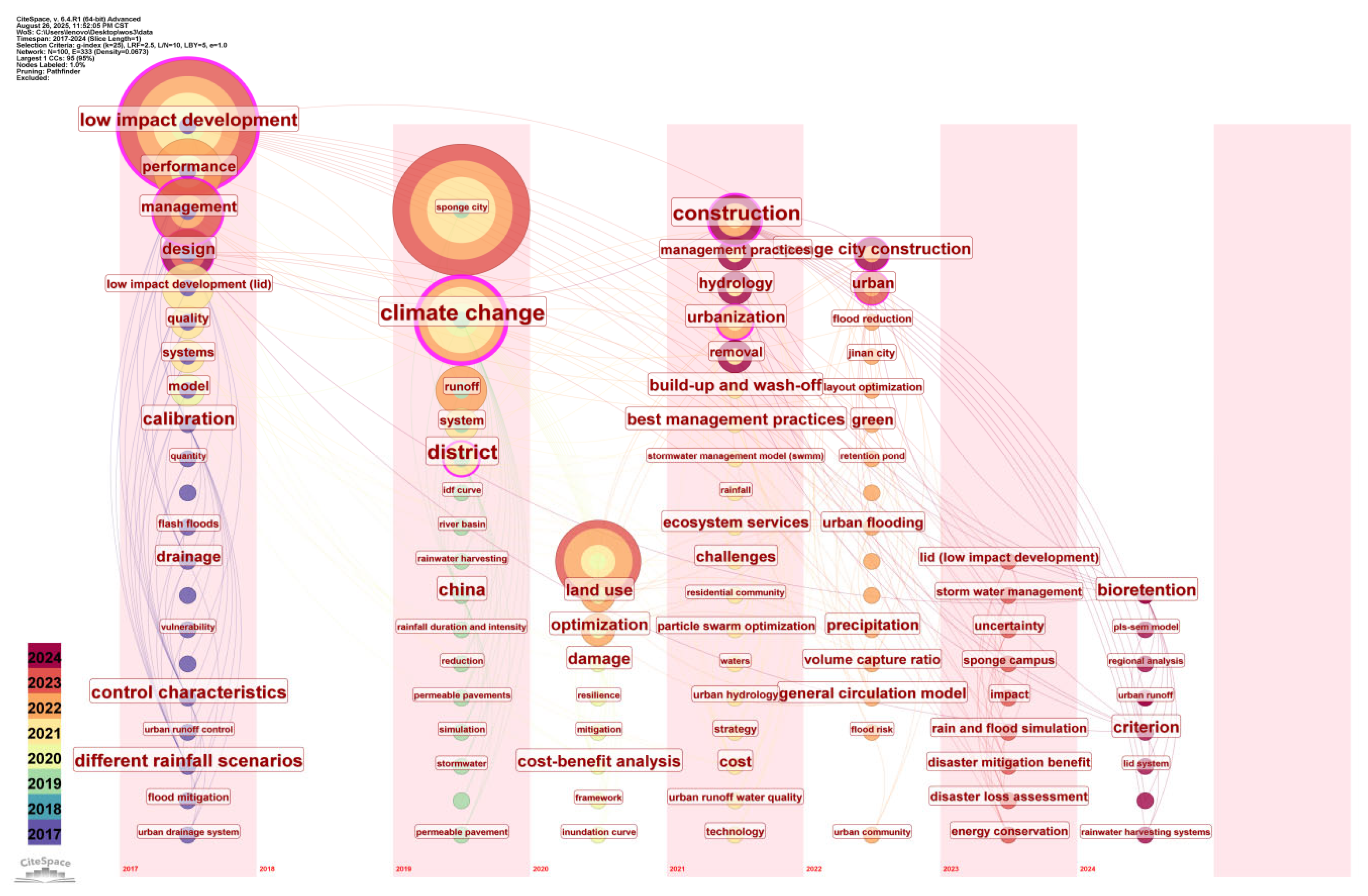
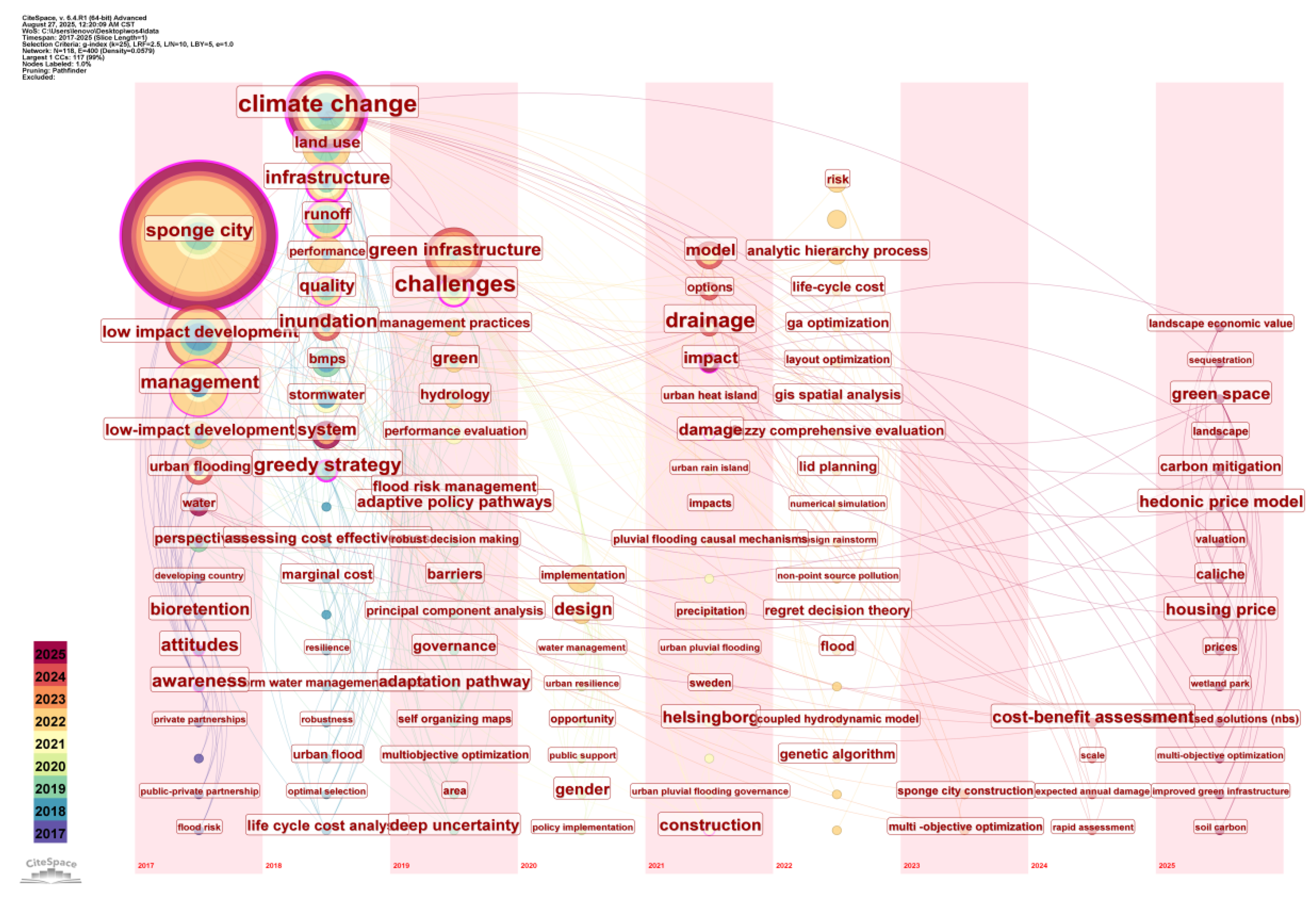
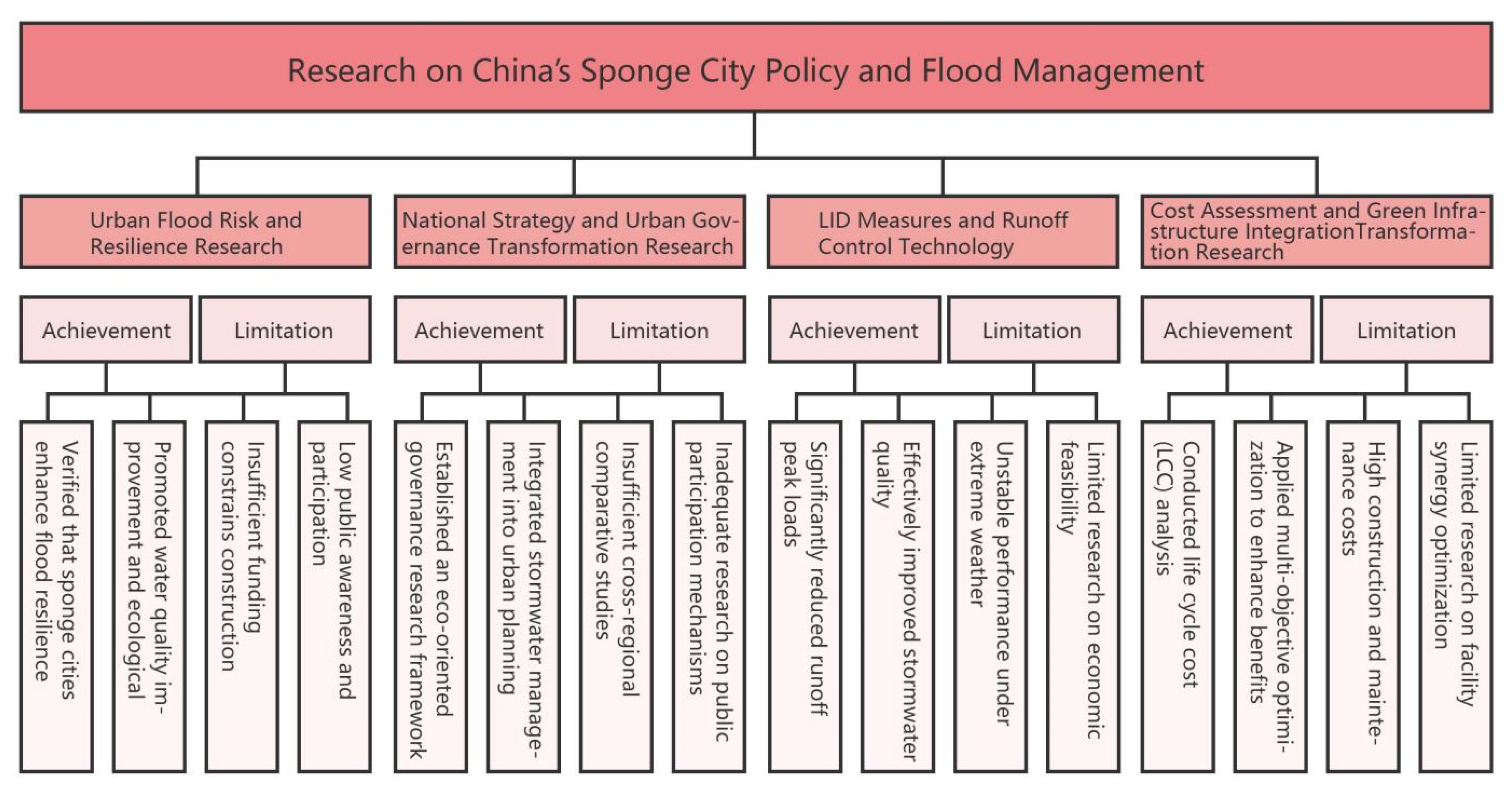
Disclaimer/Publisher’s Note: The statements, opinions and data contained in all publications are solely those of the individual author(s) and contributor(s) and not of MDPI and/or the editor(s). MDPI and/or the editor(s) disclaim responsibility for any injury to people or property resulting from any ideas, methods, instructions or products referred to in the content. |
© 2025 by the authors. Licensee MDPI, Basel, Switzerland. This article is an open access article distributed under the terms and conditions of the Creative Commons Attribution (CC BY) license (https://creativecommons.org/licenses/by/4.0/).
Share and Cite
Lu, Y.; Huang, M.; Xiao, H.; Lu, Z.; Xie, M.; Chen, K. Keyword Analysis and Systematic Review of China’s Sponge City Policy and Flood Management Research. Atmosphere 2025, 16, 1090. https://doi.org/10.3390/atmos16091090
Lu Y, Huang M, Xiao H, Lu Z, Xie M, Chen K. Keyword Analysis and Systematic Review of China’s Sponge City Policy and Flood Management Research. Atmosphere. 2025; 16(9):1090. https://doi.org/10.3390/atmos16091090
Chicago/Turabian StyleLu, Yichen, Muge Huang, Haixin Xiao, Zekun Lu, Mingjing Xie, and Kaida Chen. 2025. "Keyword Analysis and Systematic Review of China’s Sponge City Policy and Flood Management Research" Atmosphere 16, no. 9: 1090. https://doi.org/10.3390/atmos16091090
APA StyleLu, Y., Huang, M., Xiao, H., Lu, Z., Xie, M., & Chen, K. (2025). Keyword Analysis and Systematic Review of China’s Sponge City Policy and Flood Management Research. Atmosphere, 16(9), 1090. https://doi.org/10.3390/atmos16091090





